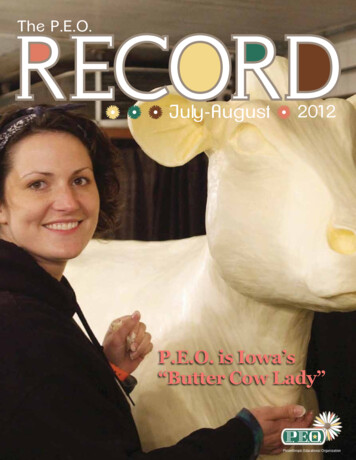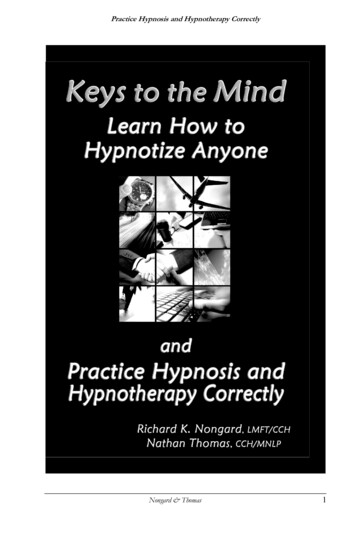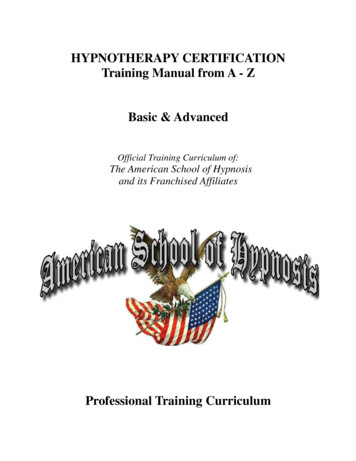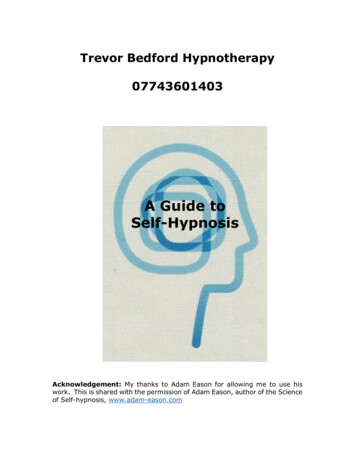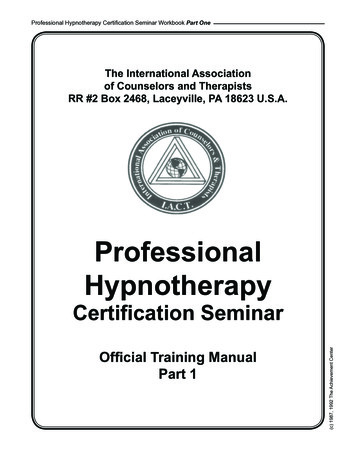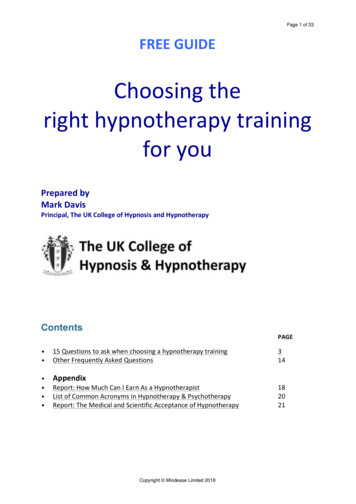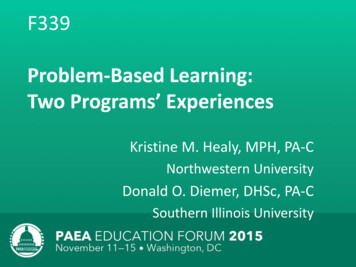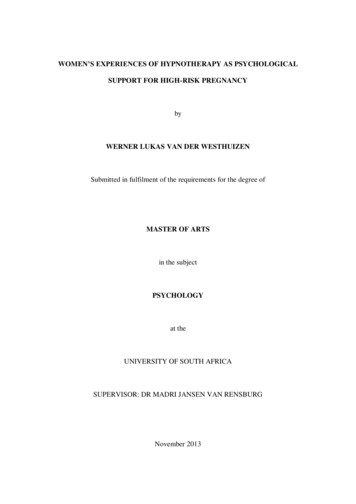
Transcription
WOMEN’S EXPERIENCES OF HYPNOTHERAPY AS PSYCHOLOGICALSUPPORT FOR HIGH-RISK PREGNANCYbyWERNER LUKAS VAN DER WESTHUIZENSubmitted in fulfilment of the requirements for the degree ofMASTER OF ARTSin the subjectPSYCHOLOGYat theUNIVERSITY OF SOUTH AFRICASUPERVISOR: DR MADRI JANSEN VAN RENSBURGNovember 2013
ACKNOWLEDGEMENTSMy heartfelt thanks to: Michelle for her support, motivation and insight in this field. You deserve much morerecognition than I can ever give. All my family and friends who supported me and believe in me. The participants who sacrificed their time and allowed me to share in their mostprivate moments. Dr Madri Jansen van Rensburg for her expert guidance and motivation. You make itall feel so easy.1
ENCESOFHYPNOTHERAPY AS PSYCHOLOGICAL SUPPORT FOR HIGH-RISK PREGNANCYis my own work and that all the sources that I have used or quoted have been indicated andacknowledged by means of complete references.WERNER VAN DER WESTHUIZEN2
ContentsLIST OF FIGURES . 6LIST OF TABLES . 7SUMMARY . 8KEY TERMS . 8CHAPTER 1 . 9INTRODUCTION. 91.1Introduction to the research study . 91.2Research questions . 111.3Objective of the study . 121.4Relevance of the study and expected benefits of research results . 121.5Overview of methodology . 131.6.Overview of chapters . 14CHAPTER 2 . 16HYPNOSIS, HYPNOTHERAPY AND HIGH-RISK PREGNANCY . 162.1Pregnancy . 162.2Prenatal and perinatal psychology . 182.3Hypnosis and hypnotherapy . 182.3.1Definitions. 182.3.2A brief history of hypnosis . 202.3.3The myths of hypnosis . 222.3.4The scope of hypnotherapy in general . 242.3.5The mind-body relationship and applications of hypnosis . 252.4The approach adopted for the purposes of this study . 312.5Hypnotherapy today . 342.6Theoretical paradigm: Ecological systems perspective . 342.6.1Individual psychology . 352.6.2Ecological systems perspective . 362.6.3Principles of an ecological systems perspective . 393
2.6.4Bronfenbrenner’s model . 432.6.5An ecological systems perspective and the research paradigm . 472.7Research findings . 49CHAPTER 3 . 50METHODOLOGY . 503.1Overview of the research questions . 503.2Research design . 513.3Sampling. 533.4Data collection . 573.5Data analysis . 583.5.1Coding . 583.5.2Process of coding and data analysis . 603.5.3Immersion . 623.5.4Conducting and transcribing the in-depth interviews . 623.6Ensuring quality in the research . 643.6.1Trustworthiness . 653.6.2The limitations of the study . 683.7Ethical considerations . 71CHAPTER 4 . 78REPORTING THE RESULTS . 78CASE STUDY 1: FELICITY’S STORY: ENDOMETRIOSIS AND HIGH-RISK CAESAREANBIRTH . 784.1Introduction to Felicity and relevance to the research. 784.2Intervention. 794.3Interviews conducted. 804.4Medically relevant information. 804.5Data analysis . 854.6Discussion. 994.7Member checking. 112CHAPTER 5 . 114REPORTING THE RESULTS . 114CASE STUDY 2: DANELLE’S STORY – PRETERM LABOUR . 1145.1Introduction to Danelle and relevance to the research . 1145.2Intervention. 1154
5.3Interviews conducted. 1155.4Medically relevant information. 1165.5Data analysis . 1165.6Discussion. 1285.7Member checking. 135CHAPTER 6 . 138REPORTING THE RESULTS . 138COMPARATIVE DATA ANALYSIS OF CASE STUDIES . 1386.1Discussion and comparison of the cases with reference to existing studies and theoreticalparadigm . 138CHAPTER 7 . 151CONCLUSION AND RECOMMENDATIONS . 1517.1 Conclusion. 1517.2 Recommendations. 1527.2.1 Recommendations regarding the use of hypnotherapy in high-risk pregnancy . 1527.2.2 Recommendations for research studies on hypnotherapy . 153REFERENCES. 155FELICITY’S CASE: INTERVIEW TRANSCRIPTS AND DATA ANALYSIS . 166APPENDIX B . 236DANELLE’S CASE: INTERVIEW TRANSCRIPTS AND DATA ANALYSIS. 236APPENDIX C . 307INFORMED CONSENT FORM . 3075
LIST OF FIGURESFigure 1: Bronfenbrenner’s ecological systems model. 45Figure 2: Bronfenbrenner’s model adapted to illustrate systems of specific interest to the study . 46Figure 3: Ecological subsystems theory: Interaction between the individual, medical personnel andpartners . 140Figure 4: Ecological subsystems theory: Biological and psychological interaction . 143Figure 5: Ecological subsystems theory: Individual and macrosystem interaction . 146Figure 6: Ecological subsystems theory: Bonding with the baby . 148Figure 7: Ecological subsystems theory: Physical and psychological subsystems interaction with worklife . 149Figure 8: Ecological subsystems theory: Complex interrelated system . 1506
LIST OF TABLESTable 1: Felicity: Codes revised to cateories . 78Table 2: Sr Melanie: Codes revised to categories .79Table 3: Sr Moniqute: Codes revised into categories . 80Table 4: Comparison of themes .82Table 5: Danelle: Codes revised into categories . 112Table 6: Ms Stabler: Codes revised into categories . 113Table 7: Dr Olivier: Codes revised into categories . 114Table 8: Comparison of themes .115Table 9: Felicity: Verbatim transcript of interview and coding . 159Table 10: Felicity: Emergent themes from categories .174Table 11: Sr Melanie: Verbatim transcript of interview and coding . 191Table 12: Sr Melanie: Emergent themes from categorie
hypnotherapy, and in particular the HypnoBirthing approach, can be useful to them when dealing with a high-risk pregnancy. Selltiz, Wrightsman and Cook (1965) emphasise three methods by which exploratory research may be done, namely a review of literature, a survey of people who had practical experiences of the problem being studied, and an analysis of insight-stimulating cases. All three .
